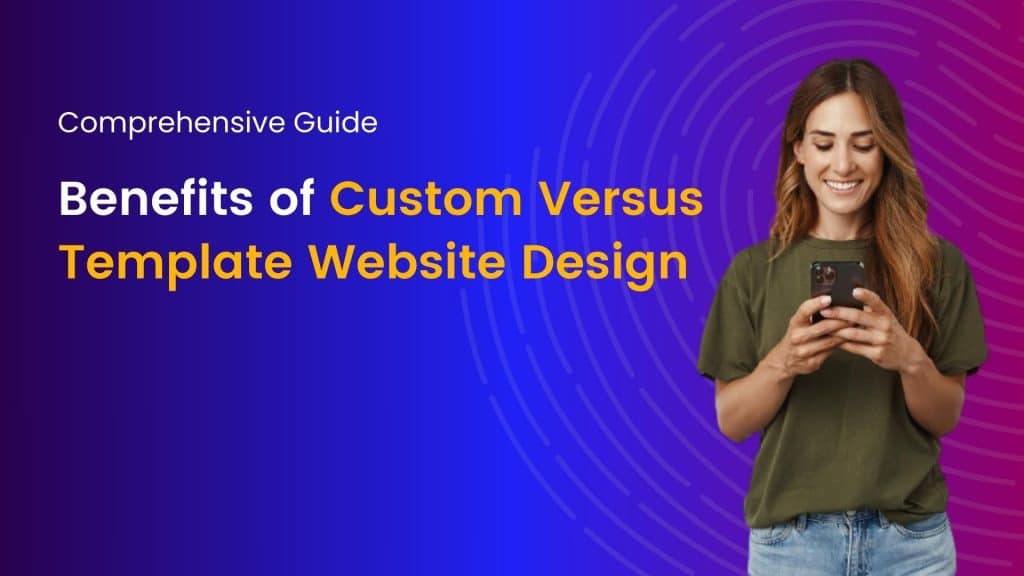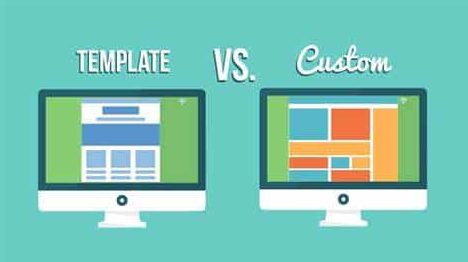In the highly competitive digital landscape that we have today, businesses must be able to make various significant decisions regarding the development of their online presence. What is often at the crux of these decisions, however is the choice between custom website design and a template website design. Custom and template-based web designs have their advantages and disadvantages. At Hostao, we seek to help businesses to make informed decisions as to which is best suited to their goals, budget, and long-term vision.
The detailed analysis will outline the key advantages and disadvantages of each of the design options, to give you an idea which of them best meets your business needs.
1. Custom Website Design: Customizing to Your Brand
In this approach, a custom website design is based on fulfilling specific needs and objectives of a brand while meeting the expectations of the target customer. This approach offers the complete flexibility and freedom to think out-of-the-box with ample space for creativity. This is one aspect where a business can really differentiate from others in any chosen market niche.
Benefits of Custom Website Design:
- Unique Branding: A custom-built website provides tools for designing every aspect and will reflect your brand’s identity. It will assure that your site is absolutely unique and one-of-a-kind for your business, and something that your competitors using similar templates can’t come anywhere close to.
- Scalability: A custom-built website centers around your business and can grow alongside it. As your business expands, you can easily add new products, services, or features without compromising the site’s performance or quality.
- Optimized Performance: Since custom websites are always built from scratch, it is possible to optimize the code with respect to performance, speed, and responsiveness. Page load speed is very important in such regards because it affects user experience while improving SEO.
- Better User Experience: Custom design can provide an experience specifically suited to your audience. Either the navigation flow is specifically suited to your audience, or the interactive elements are particularly suited to your needs. You can create a site that looks aesthetically pleasing and enables a smooth user experience as well.
- SEO-Friendly Architecture: Custom design is an application of best practices of SEO from the first day of architecture. This gives increased control over so many elements such as the URL structure, meta tags, and page hierarchy that would increase your chances to rank well in search engines.
Disadvantages of Custom Website Design
- Higher Costs: A customized website is really expensive because it takes so many man hours and expertise to be done. Pay once yields a really unique, highly functionable, and scalable site.
- Longer Development Time: It takes much longer to develop and design as compared to a template-based design. If you are looking for something that can be done within a smaller timescale or you need to get online quickly, this may not work for you.
2. Template Website Design: Quick and Affordable
Template design for websites offers a “cut and paste” of website layouts and designs that are often customized to at least a certain level. Its great advantage is that it’s a great solution for businesses that require an easy, quick, and affordable means of having a website.
Advantages of Template Website Design:
- Lower Cost: A template makes a site much easier and less costly to develop. Because one only pays the costs for developing a single site model that can be copied. This would make it fit for small businesses or startups with a limited budget. Development costs are lower, and one can have an online presence without financial burden.
- Faster Time to Launch: Because the design and basic structure are already built, templates enable you to get a website up and running much faster. That’s ideal for businesses with real need to go live quickly.
- Ease of Use: Templates are easy to use, include drag-and-drop editors, and make it easy for those who don’t know how to code to simply update information, images, and design elements.
- Responsive Designs: Most modern templates are responsive design friendly. Hence confirming your site will display fairly and work well on all devices-desk-top, tablet, or mobile.
Drawbacks of Template Website Design:
- Lack of Uniqueness: The biggest drawback of using a template is that it prevents the creation of an exclusive website. Since various businesses use templates that are similar or the same, uniqueness is hard to be achieved.
- Limited Customization: The use of templates at a minimum level allows for changes in colors, fonts, and other items. It is not as flexible as a custom website. If you need complex functionality or special design features, you are limited to a certain extent.
- Performance Issues: Templates sometimes come with additional code and features that you may not need, which in turn will slow down your website. It can influence the speed at which a page loads, which means a really important factor for user experience and search engine ranking.
- Scalability Issues: You can scale up your business, but a template-based website does not scale very well. You end up being weak at adding custom features or expanding functionality. And thus you have to redesign the whole thing sometime later.
3. Security Considerations: Custom vs. Template
Security is the most important feature of an existence on the world wide web. The increasing number of cyber attacks demand a secured website. So businesses must ensure their websites are secure in order to maintain the confidence of customers through protecting their data.
Custom Website Design: Improved Security
- Custom-Specific Security: Custom websites are developed with security from the very beginning. The developers can add those security features that are specific to your business and needs and so provide more comprehensive security.
- Fewer Chances to be Hacked through Vulnerabilities: Custom sites have fewer vulnerabilities because developers don’t use common templates and themes. Most hackers target template sites since they are familiar with the source code. In contrast, a site built with original code remains more secure, making it difficult for hackers to access and exploit.
Template Website Design: Prospective Security Risks
- Common Vulnerabilities: Templates, especially free or poorly maintained templates have already known vulnerabilities that hackers discover. Since many business sites use the same template, if a vulnerability exists in that template, hackers can easily target multiple websites once they discover the weakness.
- Vulnerability to Updates: The only sure thing about your site depending on how good the template provider is at rolling out timely updates and patches. If no updates were rolled out periodically, then your site would prove vulnerable.
4. Flexibility in Long-Term Maintenance
A website lives or dies not only at the time of its build but during the maintenance and updates it gets overtime. Another important consideration is flexibility, which is a critical choice when deciding between a custom design and a template.
Custom Website Design: Maintenance and Flexibility
- Ongoing Support and Updates: Another oft-considered benefit of a custom-built website is ongoing support from your development team. At Hostao, any custom design comes with a set maintenance plan to ensure that your site stays up-to-date, secure. And operating smoothly.
- Flexibility to Changing Trends: Custom-built websites are easier to change and adapt to changes in technology or trends. As your business changes,. Your website can be changed without major structural changes,. Which means that your business can develop smoothly and incrementally.
- In addition, you can design a management system to fit your specific operations needs on the custom-made website. That is vital, mainly for businesses that require custom-made content management solutions or special integrations with other third-party tools.
Template Website Design: Maintenance and Flexibility
- Relying on Third-Party Updates: One of the demerits of template-based websites is that one relies entirely on the will of the creator of the template to give updates and security patches. It means that your website may eventually fall behind the curve or be exposed to security holes if the given template is no longer supported.
- Limited Flexibility:Templates might provide some level of flexibility. But when one is very pressed to effect radical changes, they may meet resistance. You can’t make major changes to the underlying functionalities or structure without expert intervention. At some point, your template stops meeting the needs of your business.
5. Long-Term Growth and Future Proofing
As your business grows, so must your website. Indeed, without the proper forward thinking at the start, costly redesigns and disruptions will be inevitable.
Custom Website Design: Built for Growth and Future Proofing
- Custom sites are built to grow: Whether adding product lines, integrating third-party services. Or scaling to service a global customer base, a custom site can easily adapt with the growth of your business.
- Adaptable Infrastructure: A customized website will allow your development team to give you the flexibility to accommodate future upgrades and changes in technology.
- Smooth integration: Custom site can be easily integrated with new tools, CRMs, eCommerce platforms. And new technologies that are available in the business world – keeping you ahead of the curve for all industry trends and business demands.
Template Website Design: Limited Growth Potential
- Limited by Template Functionality: As your business grows, you may no longer find sufficient functionality that a template can offer. If there is a template that cannot allow flexibility to expand, you have to invest in the whole redesign.
- Migration Challenges: Switching from a template-based website to a custom solution is a time-consuming and expensive process if your business has already heavily invested in content. And functionality on the template platform.
6. Case Studies: Real-World Examples
To present real-life cases of benefits from custom and template designs, let’s consider two samples from Hostao’s portfolio.
Case Study 1: Custom Design for an eCommerce Brand
A rapidly expanding eCommerce company approached Hostao to design a custom website based on their lines of products expanding and offering a global base of customers. The objective was to create an individualized user experience that would encapsulate the premium image of the brand. But incorporating numerous eCommerce platforms as well as third-party services was one of the core components.
Results:
- The conversion rates increased 40 percent by optimizing the UX in this custom site.
- With flexible design, new categories of products could easily come along
- Speed up to 30% improved on the website; users actually feel welcome, and the search rankings themselves improved.
Case Study 2: Template Design for a Local Startup
Local startup needed a platform quickly to establish itself.
Hostao proposed a service that allowed startups to quickly customize a template with their branding and incorporate at least the most basic features.
Result:
- The website went live in two weeks, thus meeting the tight deadline that had been set by the startup.
- The template design saved the client 60% of the overall upfront costs.
- When the business began to grow, the company shifted into a custom design to solve the needs that came with growth. Thus, we build on the success established through template-based designs
Conclusion
After weighing all of this, the choice between custom and template website design simply boils down to what suits your business goals, budget, and timeline. Custom websites come with the highest flexibility, scalability, and performance, and this is ideal for companies. Or business that have huge long-term growth in mind. Templates, on the other hand, become a quick and cheap way into getting online, ideal for startup companies or those which do not have much.
Every business is different, and we here at Hostao know it. We will guide you through the process, confirming you end up with a beautiful and engaging design that reflects your brand, whether you choose a template or custom web design.
As a master's graduate in Computer Science, I blend my technical expertise with a passion for crafting content that simplifies complex topics. My focus is on creating clear, engaging material that resonates with a diverse audience. By staying current with trends in SEO, social media, and content strategy, I aim to produce content that not only educates but also connects, bridging the gap between technology and its users.





















